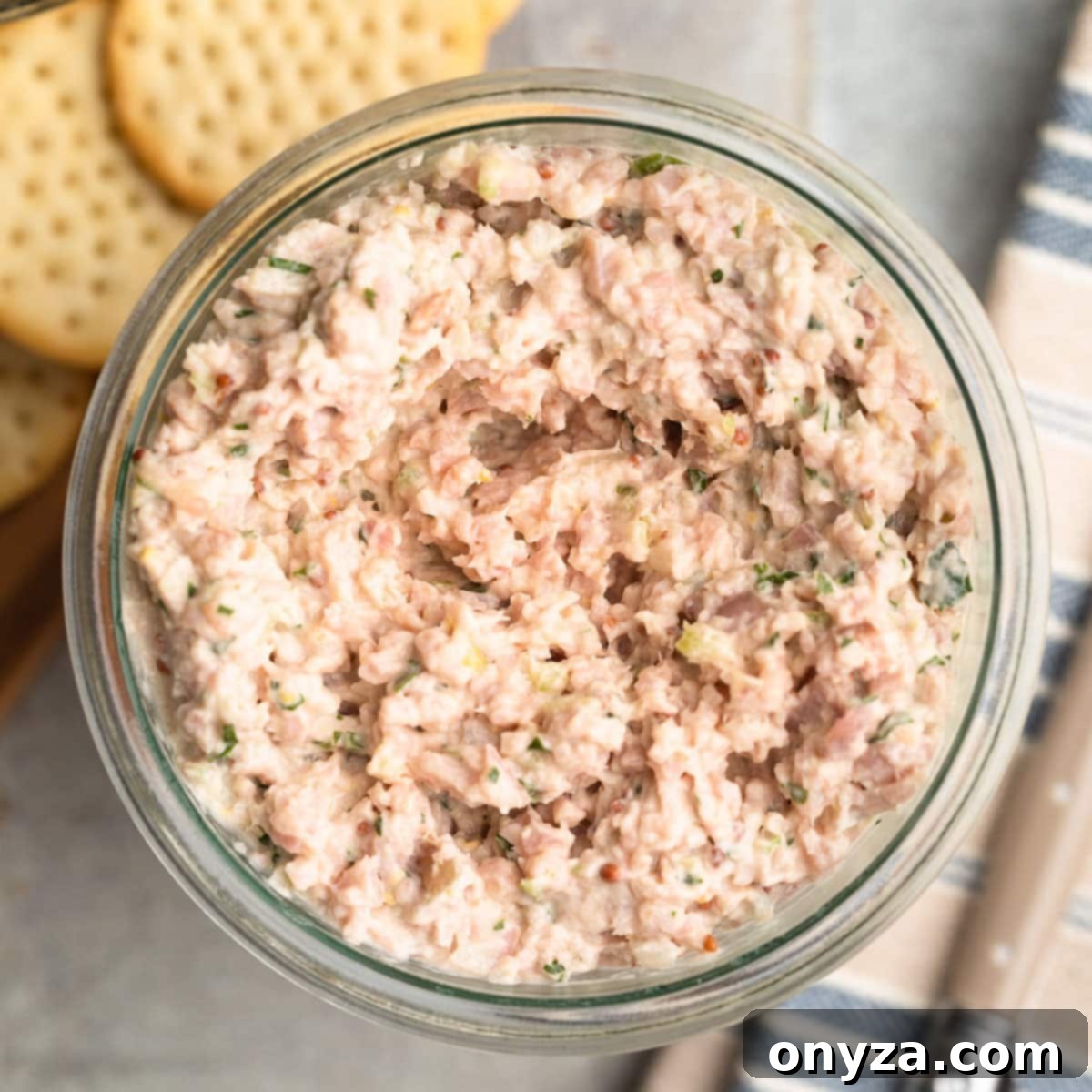Transforming holiday leftovers into something new and exciting is a culinary art, and this homemade Deviled Ham spread is a perfect example. It’s a cherished family favorite, offering a delightful blend of creamy texture, a subtle crunch, and a burst of savory, zesty, and tangy flavors in every bite. This versatile recipe can be easily customized to suit your preferred level of spiciness, making it an ideal choice for various occasions. Serve it as an elegant appetizer or simple snack with crisp crackers or fresh vegetables, a hearty sandwich for a satisfying lunch, or as a sophisticated topping for canapés or crostini at your next gathering. This recipe elevates humble ham into a gourmet experience that your taste buds will thank you for.
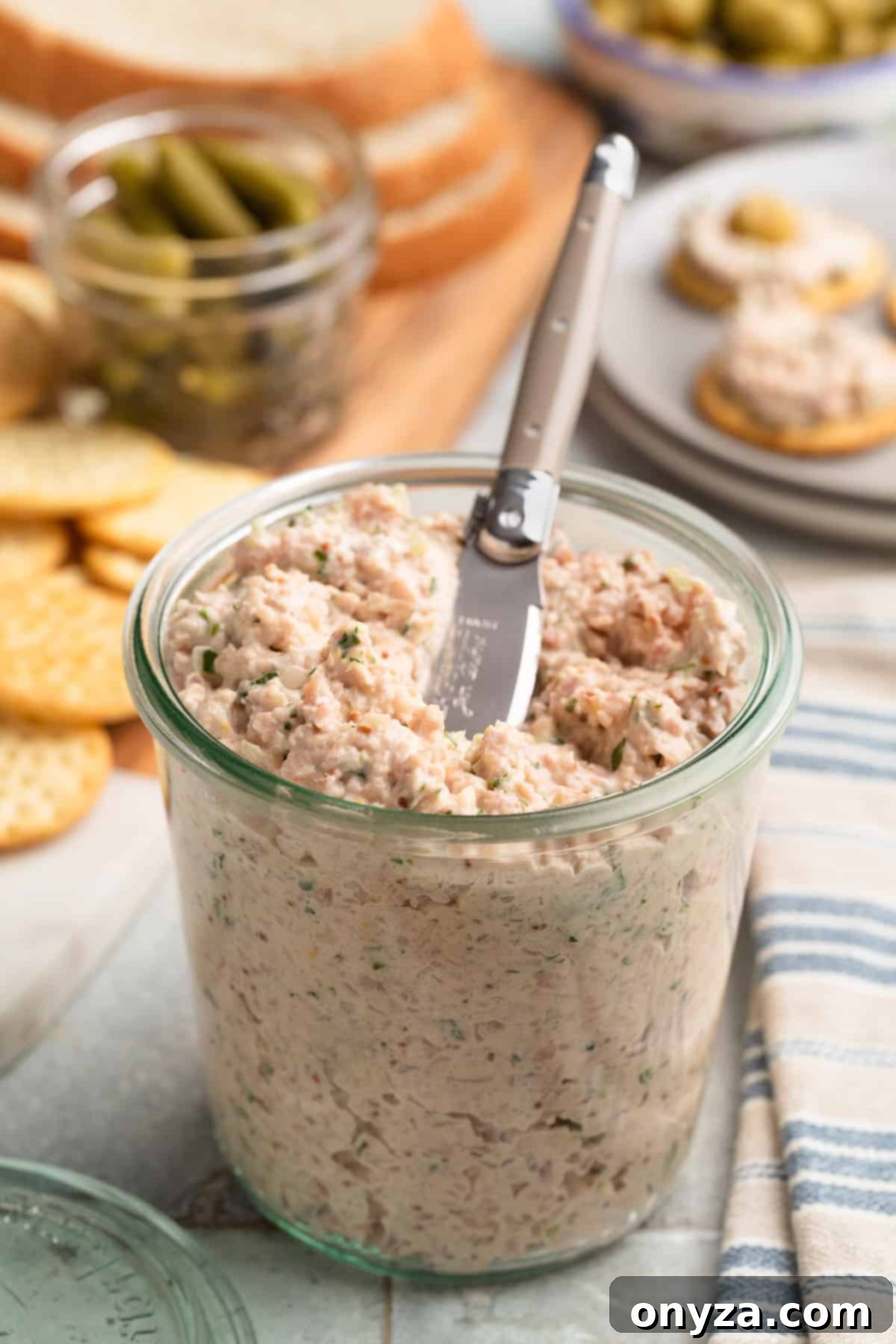
In this Post:
- What is Deviled Ham Spread?
- Why This Deviled Ham Recipe Stands Out
- Essential Ingredients and Flavor Variations
- Step-by-Step Guide to Making Deviled Ham
- Creative Serving Suggestions
- Homemade Deviled Ham Recipe
What is Deviled Ham Spread?
Deviled Ham is a beloved savory spread, meticulously crafted from finely minced or ground ham, celebrated for its distinctive zesty and often spicy kick. The intriguing term “deviled,” when used in a culinary context, traces its origins back to the 18th century. It traditionally refers to dishes that are enthusiastically seasoned with hot or piquant ingredients, reminiscent of the vibrant fillings found in popular dishes like Deviled Eggs. This vivid description evokes the “fiery” imagery commonly associated with the devil, hinting at the delightful heat within the dish.
What truly sets Deviled Ham apart from more conventional ham spreads or salads is its robust flavor profile. It is expertly seasoned with a dynamic blend of zesty components, including sharp mustard, a touch of fiery cayenne pepper, and/or a dash of piquant hot sauce. These ingredients combine to create a spread that is anything but bland, offering a tantalizing interplay of flavors that excite the palate.
Among the array of prepared brands available in today’s market, the William Underwood Company of Boston holds a significant place in culinary history. In 1868, they pioneered the creation of the very first canned Deviled Ham, a product that has since cemented its status as a ubiquitous staple on most American grocery store shelves. Underwood’s packaging is instantly recognizable and iconic—a white paper wrap adorned with a distinctive red devil logo. According to their company website, this devil logo, introduced in 1870, is widely considered to be “the oldest registered trademark for prepackaged food still in use in the United States.” This remarkable longevity underscores the product’s enduring legacy and deep roots within American food culture, making Deviled Ham a testament to both tradition and taste.
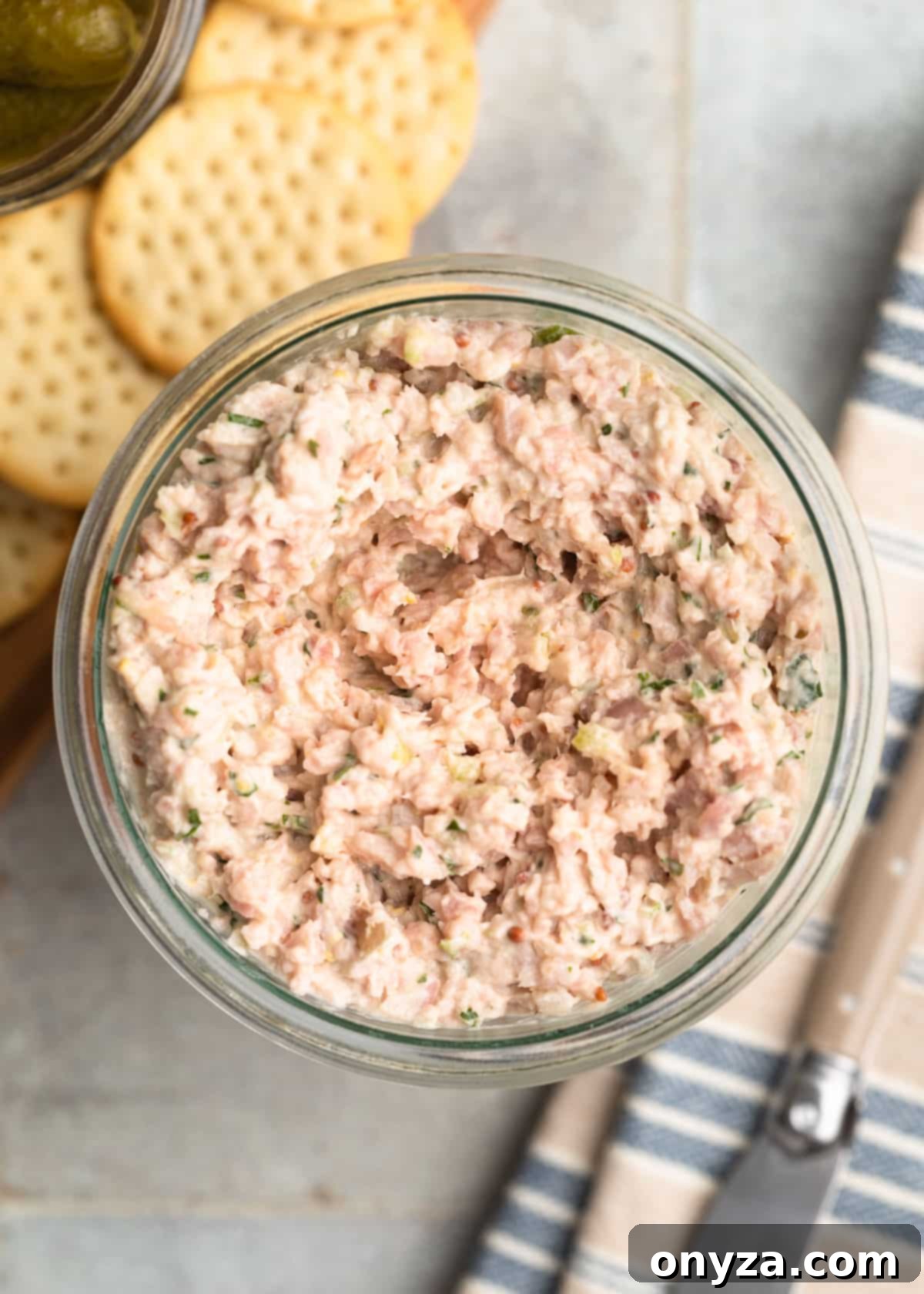
Why This Deviled Ham Recipe Stands Out
It’s important to clarify from the outset that this recipe is not designed to be a direct copycat of the nostalgic canned Deviled Ham many grew up with. While canned versions hold a special place in the hearts of many, this homemade rendition offers a distinctly different and superior experience in both flavor and texture. Here are several compelling reasons why you’ll absolutely love making this elevated version at home:
- Unmatched Flavor Profile: Our homemade Deviled Ham spread boasts a luxuriously creamier texture and is considerably less salty than its store-bought counterparts. We enhance this with the delightful addition of finely minced crunchy onion and celery, which introduce a textural counterpoint. Each forkful delivers a rich, complex symphony of savory, subtly spicy, sweet, and tangy notes, creating a truly gourmet experience.
- Perfect for Utilizing Leftovers: Deviled Ham, much like a classic ham salad, offers an ingenious and delicious solution for repurposing leftover ham from a grand holiday dinner or Sunday roast. This resourceful approach minimizes food waste and maximizes flavor. Often, when I have a bone-in ham in my refrigerator, I’ll dedicate a portion of the succulent meat to this spread, reserving the bone to craft my renowned Split Pea Soup with Ham, creating two delicious meals from one initial ingredient.
- Exceptional Versatility: The beauty of this Deviled Ham recipe lies in its incredible adaptability. It performs admirably as a savory and satisfying sandwich filler, a delightful spread for an array of crackers, or a flavorful, conversation-starting addition to an elaborate charcuterie board. Whether you’re seeking an effortless snack, a quick yet gourmet lunch, or an impressive appetizer for entertaining, this recipe effortlessly fits the bill.
- Effortlessly Customizable: Tailoring the spiciness of this spread to perfectly match your preferences is wonderfully simple. By merely adjusting the amount of hot sauce incorporated into the recipe, you can achieve anything from a mild, family-friendly flavor to an exhilarating, fiery kick. Make it as bold or as subtle as your palate desires!
- Ideal for Make-Ahead Preparation: This Deviled Ham is a dream come true for meal planners and entertainers. Its flavors are known to deepen and meld beautifully over time, making it an excellent candidate for advance preparation. We’ve found that the spread truly reaches its peak flavor after a day or two of chilling in the refrigerator, allowing all the nuanced ingredients to harmonize perfectly.
Craving more ingenious ways to utilize leftover ham? Don’t miss out on our tempting Baked Ham and Cheese Sliders, the elegant Ham and Cheese Puff Pastry Slab Pie, or the classic indulgence of a Monte Cristo Sandwich!
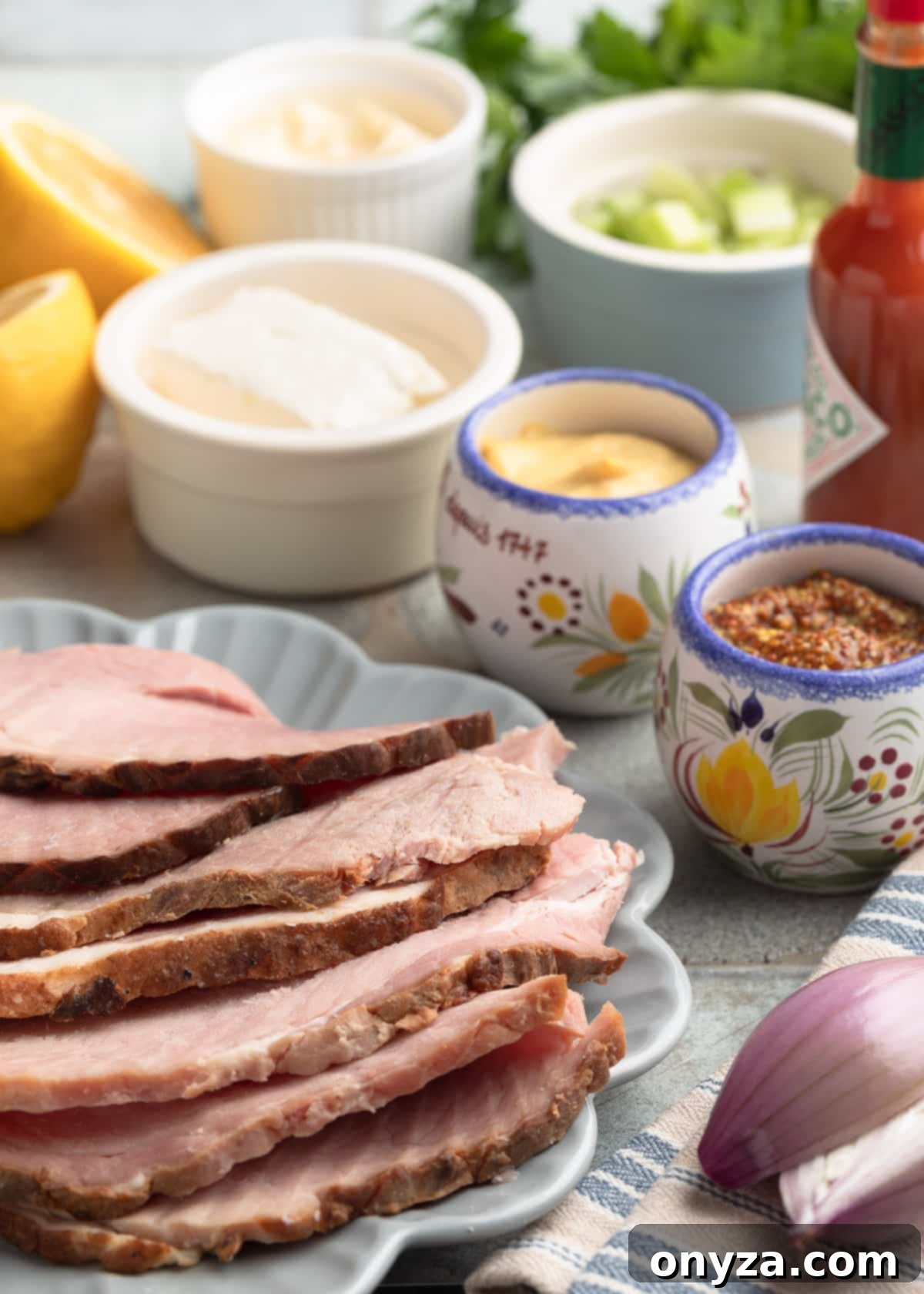
Essential Ingredients and Flavor Variations
Crafting the perfect Deviled Ham spread begins with a careful selection of high-quality ingredients, each playing a crucial role in achieving that rich, balanced flavor and irresistible texture. Here’s a detailed look at what you’ll need and how you can creatively adapt the recipe:
- Cooked Ham: The star of the show! For the best results, use succulent leftover ham from a holiday feast (such as our Honey Mustard Glazed Ham) or a hearty ham steak. It’s crucial to avoid deli ham, as its texture and often higher sodium content aren’t suitable for this spread. Before mincing, be sure to trim off any excess fat, skin, or tough, gristly bits, then roughly cut the meat into manageable chunks.
- Onion or Shallot: Both contribute a vital aromatic foundation. Choose between finely chopped sweet onion, such as Vidalia, for a milder, sweeter onion flavor, or shallots, which impart a subtly garlicky, slightly sharper, and more refined taste. The choice depends on your preference for a sweeter or more pungent note.
- Celery: Beyond its mild, earthy flavor, celery is indispensable for adding that desired crunchy texture to the spread, providing a wonderful contrast to the creamy ham.
- Mayonnaise: This binds the ingredients together, creating a cohesive and rich spread. It also contributes a luxurious creaminess and a hint of tang. While I prefer Duke’s for its distinctive Southern tang, any high-quality mayonnaise, like Hellmann’s or a freshly made homemade version, will yield excellent results.
- Cream Cheese: For optimal smoothness, ensure you use brick-style cream cheese that has been softened to room temperature. This ingredient adds a delightful tang and helps to achieve the spread’s signature rich, creamy body.
- Mustard: A combination of mustards creates depth and complexity. Smooth Dijon mustard offers a sharp, tangy note, while grainy mustard (such as Maille Old Style) adds a pleasant, subtle texture and a robust, earthy flavor.
- Hot Sauce: This is where the “deviled” magic truly happens! The amount of hot sauce allows you to fully customize the heat level. A mere ¼ teaspoon will provide a gentle warmth, while a full tablespoon will deliver a noticeably hotter bite. Classic choices like Tabasco or Frank’s Red Hot are excellent, but feel free to experiment with your favorite.
- Worcestershire Sauce: A secret weapon for umami! Worcestershire sauce contributes a complex, savory depth of flavor and a touch of tangy brightness that perfectly complements the ham.
- Flat Leaf Parsley: Freshly chopped flat-leaf parsley is essential for adding a vibrant burst of herbaceous freshness and a beautiful green fleck throughout the spread, balancing the richness.
- Brown Sugar and Ground Cloves: If your original ham wasn’t prepared with a sweet glaze, these ingredients are key. Light brown sugar allows you to sweeten the Deviled Ham to your exact taste, while a tiny pinch of ground cloves introduces a classic, warm spice note often associated with glazed hams, adding a subtle layer of complexity.
- Fresh Lemon Juice: A squeeze of fresh lemon juice is a crucial finishing touch. It brightens the entire spread, cutting through the richness with its lively, tart flavor. The precise amount needed will vary depending on the inherent acidity of your chosen hot sauce (some are more vinegary than others).
Exciting Variations to Explore
- Pickle Power: For pickle enthusiasts, incorporating a tablespoon or two of finely chopped sweet or dill pickle relish will add a fantastic tang and crunch. If you opt for sweet relish, consider reducing or omitting the brown sugar to maintain balance.
- Amplify the Heat: If you desire even more heat after adding up to a tablespoon of hot sauce, avoid adding excessive amounts of additional hot sauce, as this can make the spread overly vinegary. Instead, stir in cayenne pepper to taste, which provides pure heat without altering the vinegar balance.
- Horseradish Kick: A spoonful of prepared horseradish is another excellent way to introduce a pungent pop of heat. Be sure to drain the horseradish well before adding it to prevent excess liquid and a vinegary taste.
- Smoky Paprika: For an additional layer of warmth and a smoky undertone, a pinch of smoked paprika can be a delightful addition.
- Fresh Herbs: Beyond parsley, consider fresh dill, chives, or even a hint of tarragon for different aromatic profiles.
Step-by-Step Guide to Making Deviled Ham Spread
Crafting homemade Deviled Ham is surprisingly straightforward, a quality I particularly appreciate, especially after the culinary endeavors of a holiday dinner. For optimal texture and flavor integration, I favor a two-step process: initiating the mincing in my food processor and then meticulously finishing the mixing by hand in a bowl. This method ensures control over the texture, yielding a spread that is both perfectly creamy and wonderfully chunky.
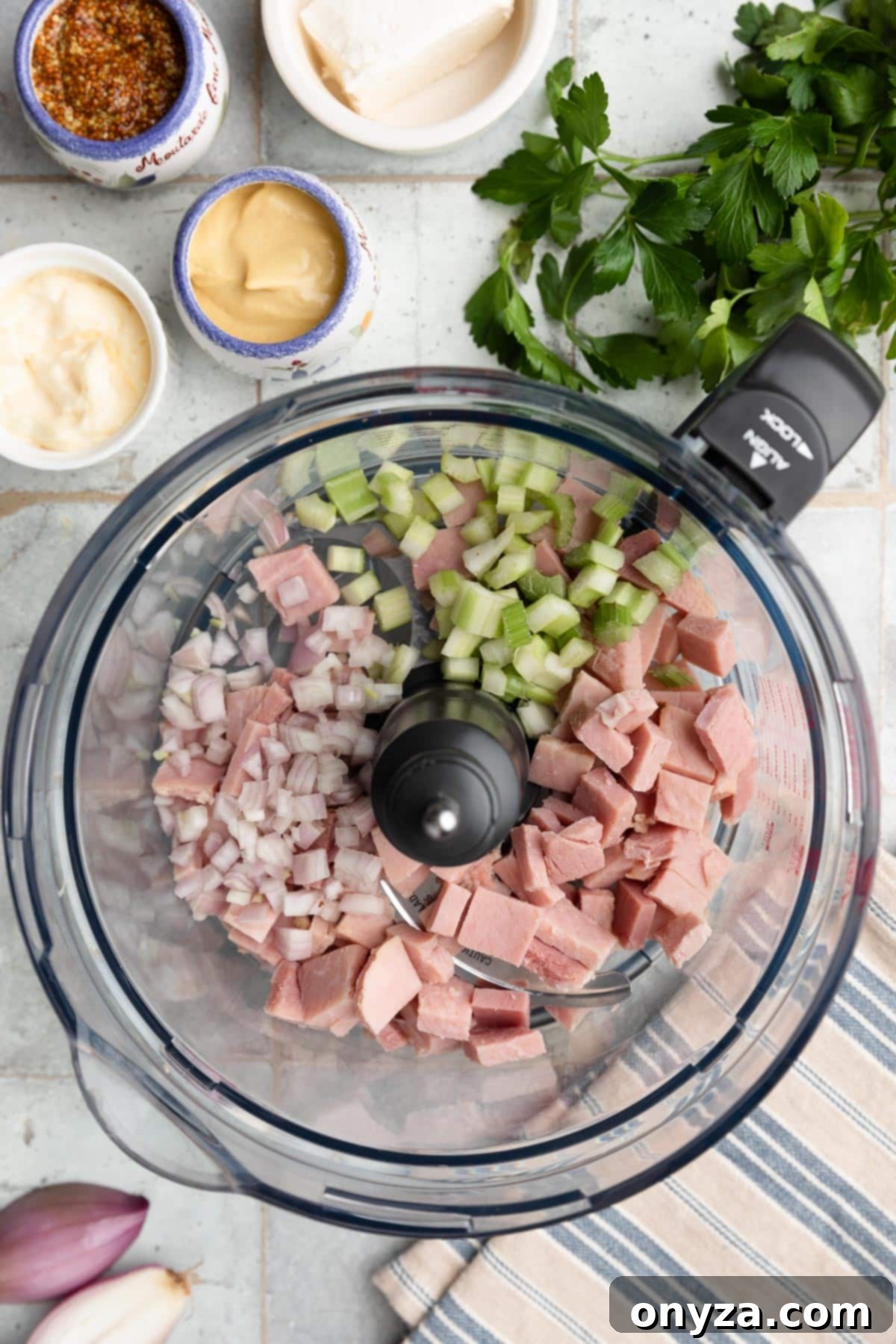
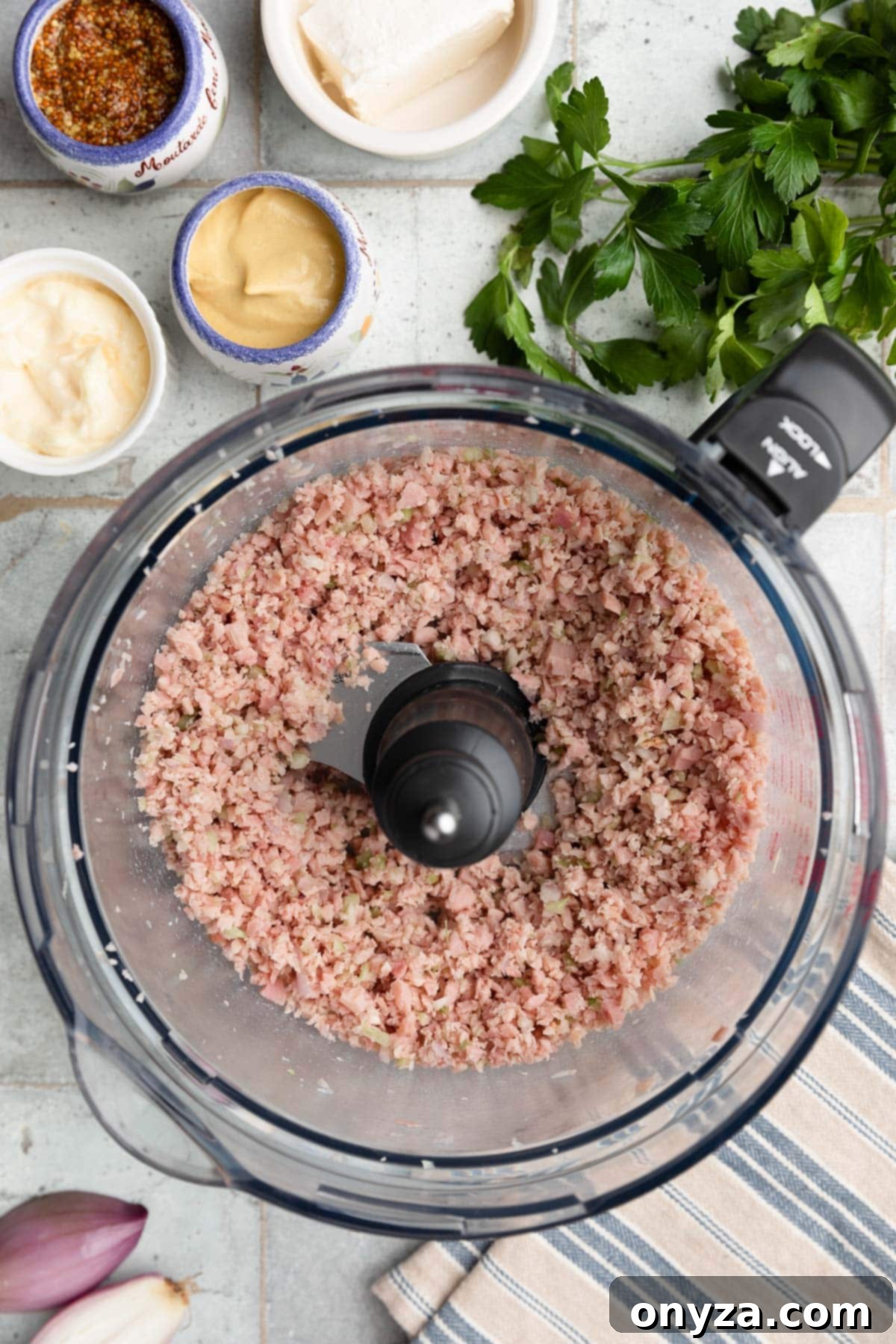
Step 1: The Food Processor Precision
Begin by preparing your ham: cube or tear it into manageable pieces. Likewise, roughly chop your onions (or shallots) and celery by hand. This crucial pre-chopping step serves two purposes: it allows for more accurate measurement of your ingredients and, more importantly, ensures that the onions and celery will mince evenly alongside the ham without the risk of over-processing the meat into an undesirable paste.
Next, transfer the ham, celery, and onions/shallots into your food processor, fitted with the blade attachment. For a spreadable Deviled Ham that retains a pleasant, discernible texture (as beautifully illustrated in the accompanying photos), process the mixture using 10-12 quick, one-second pulses. This careful pulsing technique achieves a finely minced consistency that is perfect for spreading while still offering a delightful bite.
The number of pulses is your key to customization. Fewer pulses will result in a chunkier, more “ham-salad”-like consistency, ideal for those who prefer a robust texture. Conversely, more pulses will yield a progressively smoother spread, closer to a pâté. Experiment and adjust the number of pulses based on your personal preference and the specific power and efficiency of your food processor.

Step 2: Finishing and Flavor Development By Hand
Once your ingredients are perfectly minced, transfer the mixture from the food processor to a large mixing bowl. Now, it’s time to incorporate the creamy and flavorful binding agents. Using a sturdy spoon or spatula, thoroughly blend in the softened cream cheese, rich mayonnaise, savory Worcestershire sauce, both types of mustards (Dijon and grainy), and the finely chopped flat-leaf parsley. Mix until all ingredients are well combined and the spread is uniform.
The next crucial step is seasoning to taste. Gradually add the hot sauce, brown sugar (if using), ground cloves (if using), and fresh lemon juice. Start with smaller amounts and incrementally adjust until you achieve your desired balance of heat, sweetness, and tang. It’s always easier to add more than to correct an over-seasoned dish.
Typically, the ham itself provides ample saltiness to the spread. However, if you’ve used a low-sodium ham or find the flavor lacking, you can add a pinch or two of extra salt. Taste and adjust meticulously, ensuring every flavor note sings.
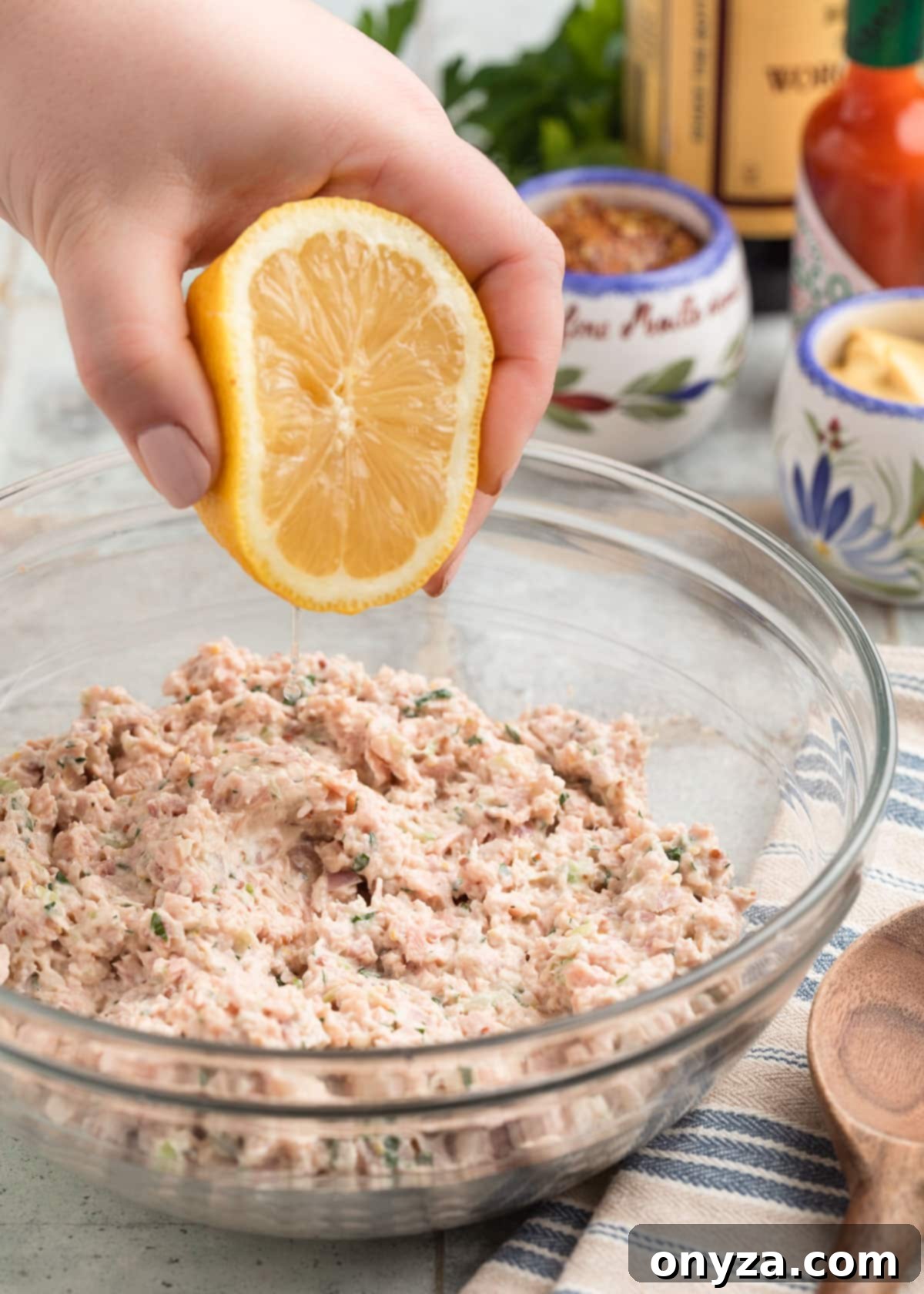

For the most exquisite flavor and perfect texture, the Deviled Ham requires dedicated chilling time in the refrigerator. This period is crucial, allowing all the distinct flavors to marry and integrate, deepening and becoming more harmonious. Additionally, the cold will help the cream cheese firm up slightly, ensuring the mixture achieves its ideal thick, spreadable consistency.
Cover the Deviled Ham tightly and refrigerate it for a minimum of 2-4 hours. While it’s delicious after this initial chill, you’ll discover that the flavors truly reach their peak and meld magnificently when left to chill overnight. This makes it an ideal make-ahead appetizer or component for entertaining. Stored in an airtight container, the spread will maintain its quality and freshness in the fridge for up to 5 days, though its exact shelf life will depend on the original freshness of the cooked ham you used.
Can the entire recipe be made in the food processor?
While it’s technically possible, I generally advise against processing all ingredients together. The powerful blades of a food processor can quickly transform the mixture into an overly smooth, almost puréed consistency, especially when incorporating the cream cheese and mayonnaise. My preferred two-step method helps preserve some textural integrity, providing a more engaging mouthfeel. That said, if your preference leans towards a very smooth, pâté-like Deviled Ham, you can certainly add all the ingredients to the food processor from the outset and pulse until you achieve your desired, perfectly silky texture.
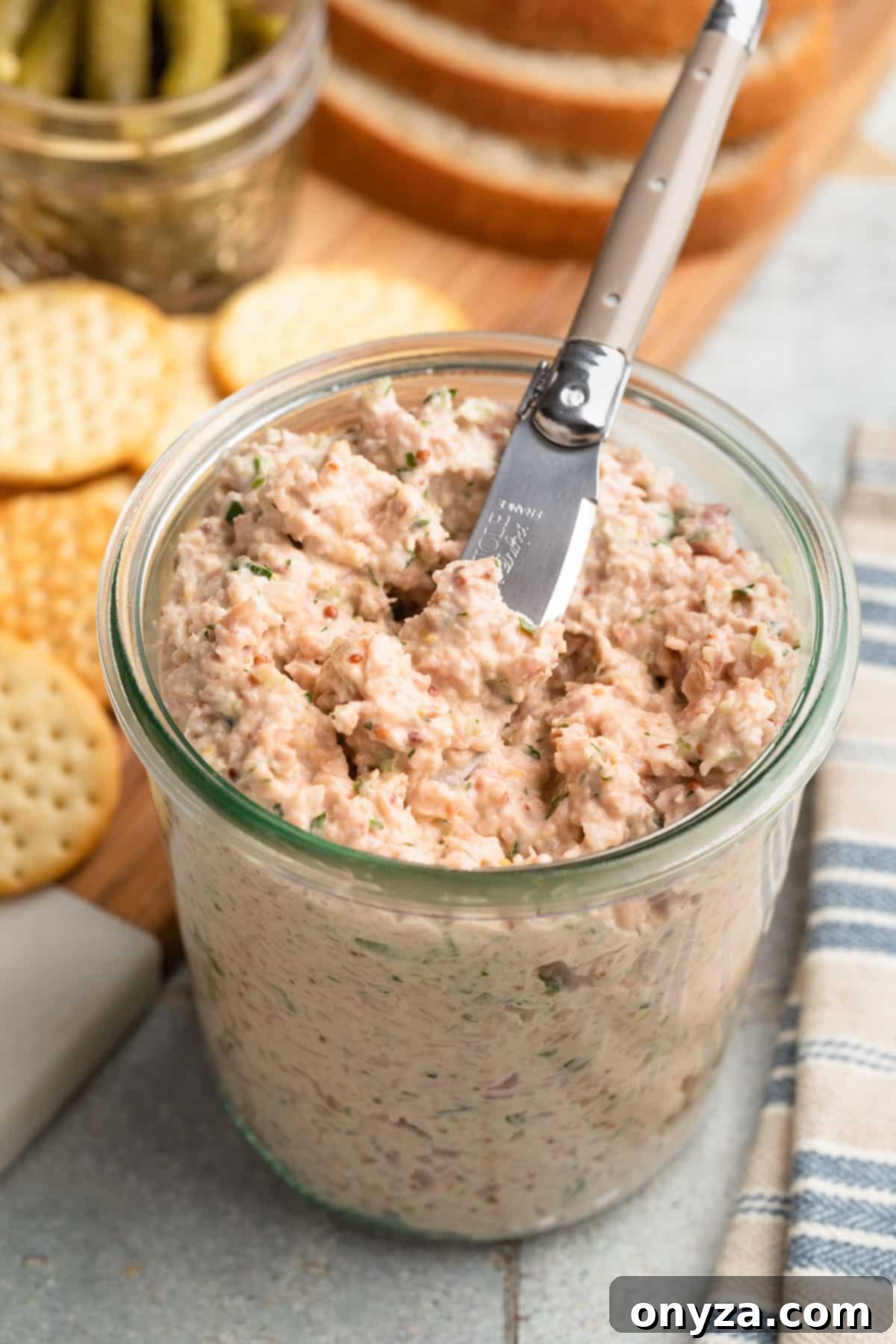
Creative Serving Suggestions
As highlighted earlier, Deviled Ham is an incredibly versatile addition to your culinary repertoire, effortlessly adapting to a range of occasions. Whether you’re planning a casual mid-afternoon snack, an elegant hors d’oeuvre for a sophisticated brunch or lively party, or simply a comforting lunch, this spread rises to the occasion. Here are some delightful ways my family and I cherish and enjoy this flavorful creation:
On Crackers: This is arguably the most classic and satisfying way to enjoy Deviled Ham. We often spread it generously onto whatever crackers we happen to have on hand. For the ultimate experience, I highly recommend a buttery, sturdy cracker, such as Club or Buttercrisp, which provides a perfect textural contrast. It’s also wonderfully delicious on simple saltines.
Canapés or Crostini: Elevate your entertaining with elegant party bites. A dollop of Deviled Ham makes a fantastic topping for small slices of cocktail rye bread, thin rounds of toasted baguette, or crispy crostini toasts. These sophisticated vessels transform the spread into an impressive starter.
With Fresh Veggies: For a lighter, fresher approach or as a beautiful hors d’oeuvre, hollow out small cherry tomatoes and fill them with the creamy spread. Alternatively, use it to top crisp cucumber rounds or crunchy celery sticks. It also pairs beautifully alongside a colorful array of crudités, such as bell pepper strips, carrot sticks, and broccoli florets. For an impeccably neat and attractive presentation when filling or topping vegetables, consider using a pastry bag fitted with a star tip.
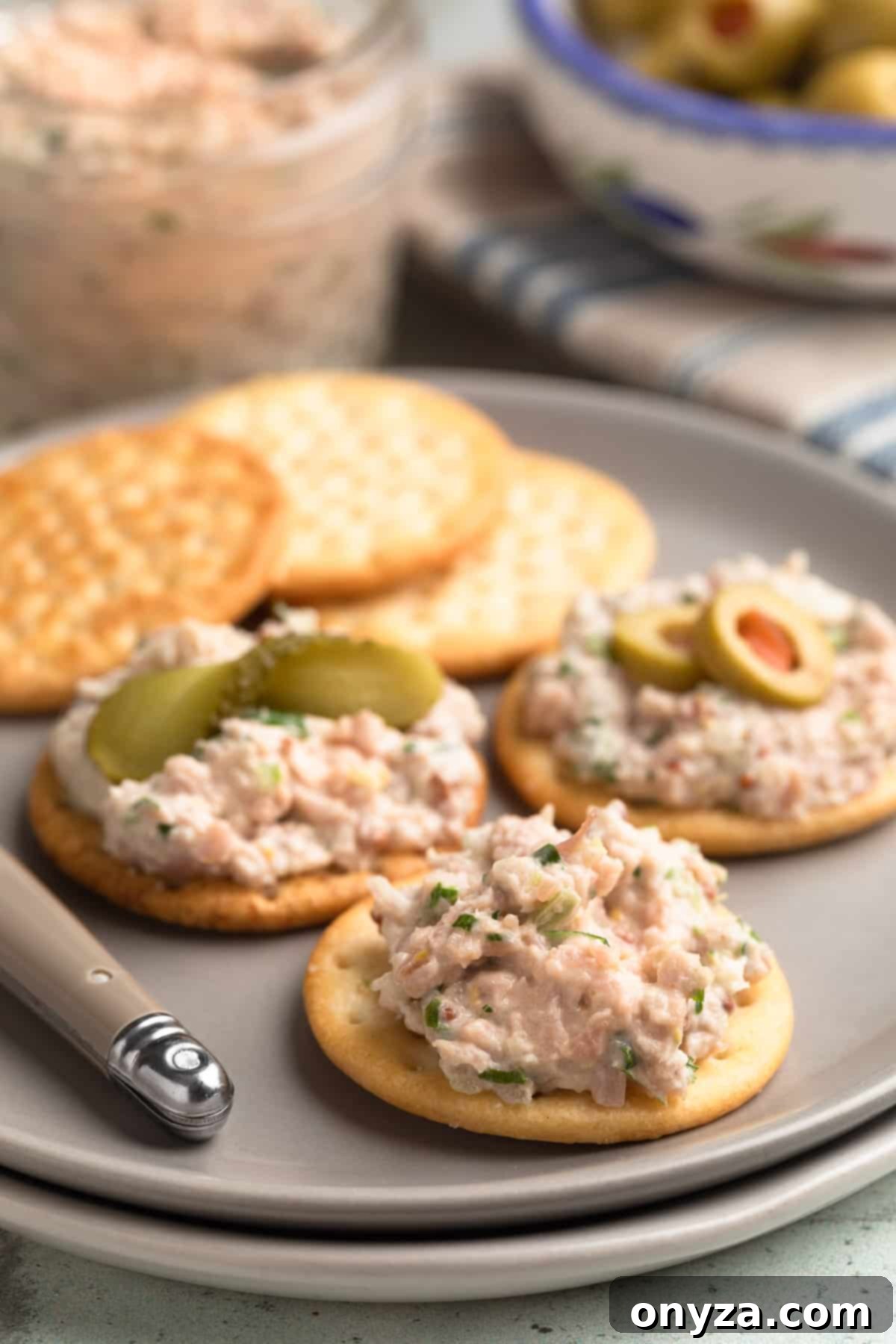
Hearty Sandwiches: Create an incredibly satisfying and flavorful sandwich by spreading Deviled Ham generously onto your favorite bread. It’s delightful on its own or enhanced with a crisp leaf of lettuce. We particularly love it on soft, pillowy white bread, robust rye, or dense pumpernickel. For a more sophisticated twist, try it on miniature brioche rolls or flaky buttermilk biscuits.
As a Deviled Egg Filling Reinvention: For a truly unique and flavor-packed twist on classic Deviled Eggs, combine this savory spread with mashed hard-boiled egg yolks. You’ll typically need approximately ½ cup of Deviled Ham to perfectly fill a dozen hard-boiled eggs, creating an unforgettable appetizer.
Elegant Garnishes: Enhance any of these serving ideas with thoughtful garnishes to introduce an additional layer of flavor and visual appeal. We adore topping our Deviled Ham with thinly sliced cornichons (miniature pickles) and vibrant pimento-stuffed olives (as gracefully shown above). Alternatively, a sprinkle of fresh, finely chopped herbs like dill, chives, or even a hint of paprika can add both freshness and color.
CRAVING MORE? Subscribe to our newsletter for exclusive recipes and culinary inspiration, and join us on Facebook, Pinterest, and Instagram for the latest updates and delicious ideas!
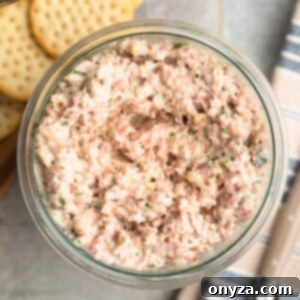
Print Recipe
Homemade Deviled Ham
Amanda Biddle
Transform your leftover holiday ham into this easy homemade Deviled Ham spread. Mixed with cream cheese, mayonnaise, and seasonings, this savory, tangy, zesty spread is easy to customize to fit your flavor preferences. Whether you’re looking for a quick snack, a party appetizer, or a unique sandwich filling, this recipe is as versatile as it is delicious.
15 minutes
2 hours
2 hours 15 minutes
8 servings (1/4 cup)
Ingredients
- 8 ounces cooked ham (such as leftover baked ham or a ham steak; not deli ham), cubed (a scant 2 cups)
- ¼ cup chopped shallot or sweet onion
- ¼ cup diced celery (about 1 rib)
- 2 ounces brick-style cream cheese, room temperature
- ¼ cup mayonnaise (such as Duke’s or Hellmann’s)
- 1 tablespoon grainy mustard (I use Maille Old Style)
- 1 teaspoon Dijon mustard
- 1 teaspoon Worcestershire sauce
- 1 tablespoon finely chopped flat-leaf parsley
Ingredients You’ll Add to Taste (see note)
- hot sauce (such as Tabasco or Frank’s Red Hot, 1/4 to 3 teaspoons)
- light brown sugar (1 to 3 teaspoons)
- fresh lemon juice (1/2 to 3 teaspoons)
- ground cloves (pinch)
Instructions
Place the ham, onion or shallot, and celery in the bowl of a food processor. Pulse 10-12 times (using 1-second pulses), until the mixture is finely-minced.
Transfer the mixture to a large bowl and stir in the softened cream cheese, mayonnaise, mustards, Worcestershire sauce, and parsley. Add the hot sauce, brown sugar, lemon juice, and pinch of ground cloves to taste.
Cover the spread and refrigerate for at least 2-4 hours for the flavors to meld. The flavor will be best after the mixture is chilled overnight.
Serve this Deviled Ham chilled with crackers, crudités, or as a sandwich. For more ideas, see the “Serving Suggestions” section in the article above.
To store the spread, keep it in an airtight container in the fridge for up to 5 days, depending on the freshness of the ham you’ve used.
Notes
*I’ve chosen not to give exact quantities of these ingredients, as they will vary based on your personal taste and the other ingredients you’re using. For instance, if you’re using a glazed holiday ham, you might not need to add brown sugar or cloves to the recipe. Similarly, the amount of hot sauce is entirely up to your personal heat preferences. (I recommend starting with 1/4 teaspoon for a mild spread and increasing as needed). Since hot sauce is vinegary, the amount (and brand) you use will determine how much lemon juice you need to add.
I don’t recommend adding more than a tablespoon of hot sauce to the recipe, so it doesn’t become too vinegary. To add additional heat, stir in ground cayenne pepper, to taste. For additional ways to customize this Deviled Ham, see the “Variations” section in the article above.
Texture: For a smoother spread, pulse the ham, onions, and celery more finely in the food processor. For a chunkier texture, pulse it fewer times.
Nutrition Estimate
Serving: 0.25 cup | Calories: 107 kcal | Carbohydrates: 3g | Protein: 7g | Fat: 8g | Saturated Fat: 1g | Polyunsaturated Fat: 3g | Monounsaturated Fat: 2g | Trans Fat: 0.01g | Cholesterol: 24mg | Sodium: 469mg | Potassium: 148mg | Fiber: 0.4g | Sugar: 2g | Vitamin A: 68IU | Vitamin C: 8mg | Calcium: 35mg | Iron: 0.5mg
Nutrition information is automatically calculated, so should only be used as an approximation.
Please note that our recipes have been developed using the US Customary measurement system and have not been tested for high altitude/elevation cooking and baking.
